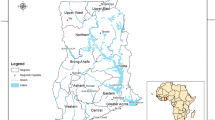Abstract
Water inrush through a mine floor is a complicated nonlinear phenomenon, which is controlled by multiple factors. Different coal seams can have different vulnerabilities, even if they are in the same mine and the same district. To assess the differences in vulnerability between multiple coal seams, we used data from three coal seams of the Tashan Coal Mine. Analysing the results indicates that the vulnerable index method, which incorporates GIS, has many potential advantages in evaluating the likelihood of water inrushes compared to the water inrush coefficient method that has traditionally been used in China.








Similar content being viewed by others
References
Ma L (2003) Standardization of statistical data—dimensionless method. Beijing Stat 2003(3):34–35
Pan H, Zhang D (2006) Some problems of AHP and the improving method. Aero Weaponry 6: 16:16–17
Saaty TL (1977) A scaling method for priorities in hierarchical structures. J Math Psychol 15:234–281
Saaty TL (1980) The analytic hierarchy process. McGraw-Hill, New York, pp 112–155
Wu Q, Jin Y (1995) The decision system of water control in mines of north china type coal fields. Coal Industry Publ House of China, Beijing, pp 45–51
Wu Q, Zhou W (2008) Prediction of groundwater inrush into coal mines from aquifers underlying the coal seams in China: vulnerability index method and its construction. Environ Geol 55(4):245–254
Wu Q, Wang J, Liu D, Cui F, Liu S (2007a) The new practical evaluation method of floor water inrush. IV: application of AHP type vulnerability index method based on GIS. J Chin Coal Soc 34(2):233–238
Wu Q, Xie S, Pei Z, Ma J (2007b) The new practical evaluation method of floor water inrush. III: application of ANN type vulnerability index method based on GIS [J]. J Chin Coal Soc 32(12):1301–1306
Wu Q, Zhang Z, Ma J (2007c) The new practical evaluation method of floor water inrush. I: the establishment of the main controlling index system. J Chin Coal Soc 32(1):42–47
Wu Q, Zhang Z, Zhang S, Ma J (2007d) The new practical evaluation method of floor water inrush. II: The vulnerability index method. J Chin Coal Soc 32(11):1121–1126
Wu Q, Zhou W, Pan G, Ye S (2009a) Application of a discrete-continuum model to karst aquifers in North China. Ground Water 47(3):453–461
Wu Q, Zhou W, Wang J, Xie S (2009b) Prediction of groundwater inrush into coal mines from aquifers underlying the coal seams in China: application of vulnerability index method to Zhangcun Coal Mine, China. Environ Geol 57(5):1187–1195
Zhang D, Zheng S, Sun Y, Ji J (1994) Changping, geographic information system technology and the application in prediction of coalmine water disaster. China University of Mining and Technology, Beijing
Author information
Authors and Affiliations
Corresponding author
Rights and permissions
About this article
Cite this article
Qiang, W., Yuanzhang, L. & Liu, Y. Using the Vulnerable Index Method to Assess the Likelihood of a Water Inrush through the Floor of a Multi-seam Coal Mine in China. Mine Water Environ 30, 54–60 (2011). https://doi.org/10.1007/s10230-010-0125-1
Received:
Accepted:
Published:
Issue Date:
DOI: https://doi.org/10.1007/s10230-010-0125-1




